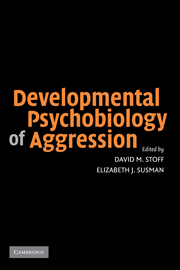Book contents
- Frontmatter
- Contents
- Foreword
- INTRODUCTION
- PART I PLASTICITY
- PART II BIDIRECTIONALITY
- 6 Touch Deprivation and Aggression Against Self Among Adolescents
- 7 Intersections of Biology and Behavior in Young Children's Antisocial Patterns: The Role of Development, Gender and Socialization
- 8 Life-Course Persistent and Adolescence-Limited Antisocial Males: Longitudinal Followup to Adulthood
- 9 A Biocultural Life History Approach to the Developmental Psychobiology of Male Aggression
- PART III GENE–ENVIRONMENT INTERACTIONS
- CONCLUSION
- Author Index
- Subject Index
- References
6 - Touch Deprivation and Aggression Against Self Among Adolescents
Published online by Cambridge University Press: 14 July 2009
- Frontmatter
- Contents
- Foreword
- INTRODUCTION
- PART I PLASTICITY
- PART II BIDIRECTIONALITY
- 6 Touch Deprivation and Aggression Against Self Among Adolescents
- 7 Intersections of Biology and Behavior in Young Children's Antisocial Patterns: The Role of Development, Gender and Socialization
- 8 Life-Course Persistent and Adolescence-Limited Antisocial Males: Longitudinal Followup to Adulthood
- 9 A Biocultural Life History Approach to the Developmental Psychobiology of Male Aggression
- PART III GENE–ENVIRONMENT INTERACTIONS
- CONCLUSION
- Author Index
- Subject Index
- References
Summary
INTRODUCTION
Increasing trends for suicidal ideation and attempts among adolescents highlight the need for identifying risk factor profiles and interventions. In a recent survey study we reported that depression, anger, number of friends, and marijuana contributed to 66% of the variance on suicidal ideation in adolescents. In other studies with depressed adolescents we were able to reduce depression and suicidal ideation by massage therapy. The model explored in this paper on adolescents' suicidal ideation and suicidal attempts is (1) that depression, aggression, and body dissociation (physical anhedonia and higher thresholds to stimulation and pain) that may have derived from early touch deprivation/abuse may mediate suicidal ideation and attempts; and (2) that suicidal ideation and attempts might be reduced by massage therapy, a treatment that has already been effective with depressed adolescents. Underlying the risk factors for suicidal ideation and attempts are abnormal physiological factors including EEG alpha asymmetry and biochemical imbalances including depressed serotonin and elevated cortisol levels. Thus, some of the intervening mechanisms between touch deprivation/abuse and suicide may be the physiological (EEG asymmetry) and biochemical imbalances (depressed serotonin and elevated cortisol levels) that accompany depression and self-destructive behavior. Massage therapy may reduce suicidal ideation/behavior via reducing depression and cortisol levels and elevating serotonin levels and thereby reducing self-destructive behavior.
TOUCH DEPRIVATION AND AGGRESSION AGAINST SELF (SUICIDE) AMONG ADOLESCENTS
The critical importance of researching adolescent suicide is underscored by the fact that suicide is the biggest killer of adolescents in the United States (Madge & Harvey, 1999), and the United States has one of the highest suicide rates among industrialized countries (Weissman et al., 1999).
- Type
- Chapter
- Information
- Developmental Psychobiology of Aggression , pp. 117 - 140Publisher: Cambridge University PressPrint publication year: 2005
References
- 7
- Cited by

